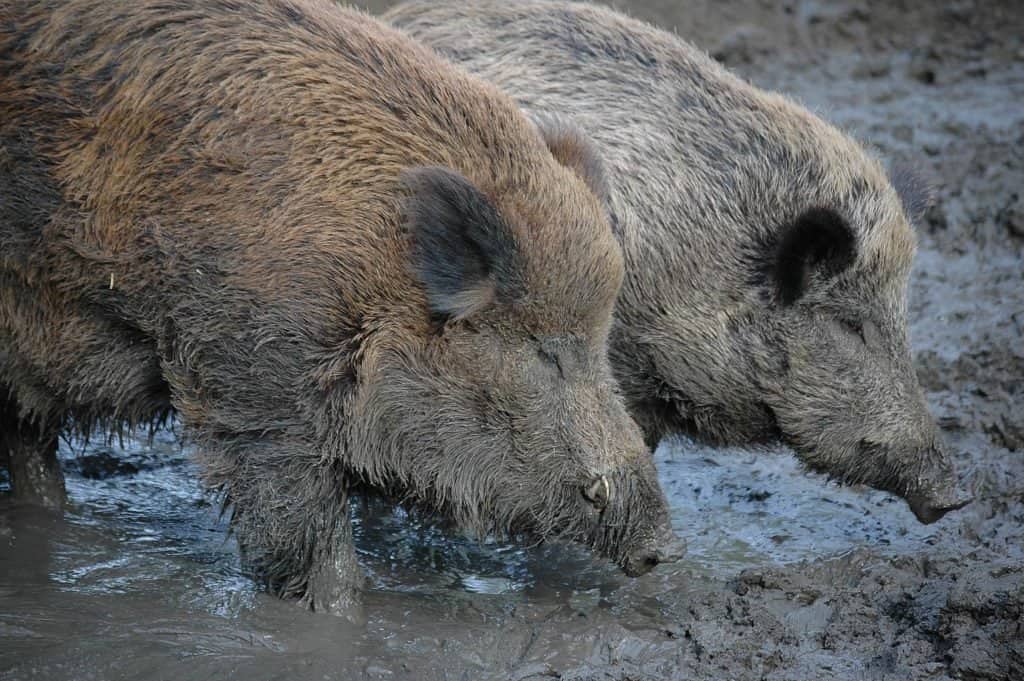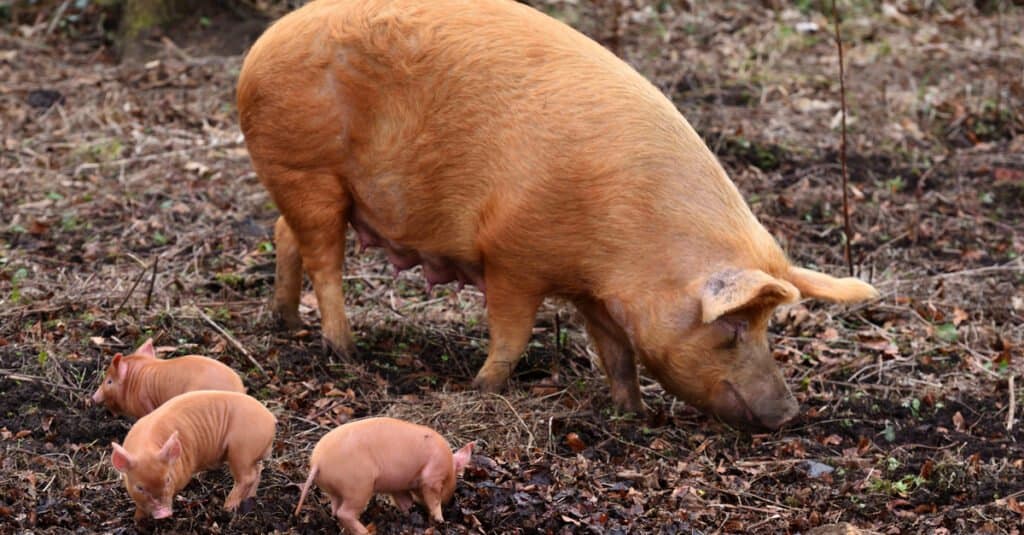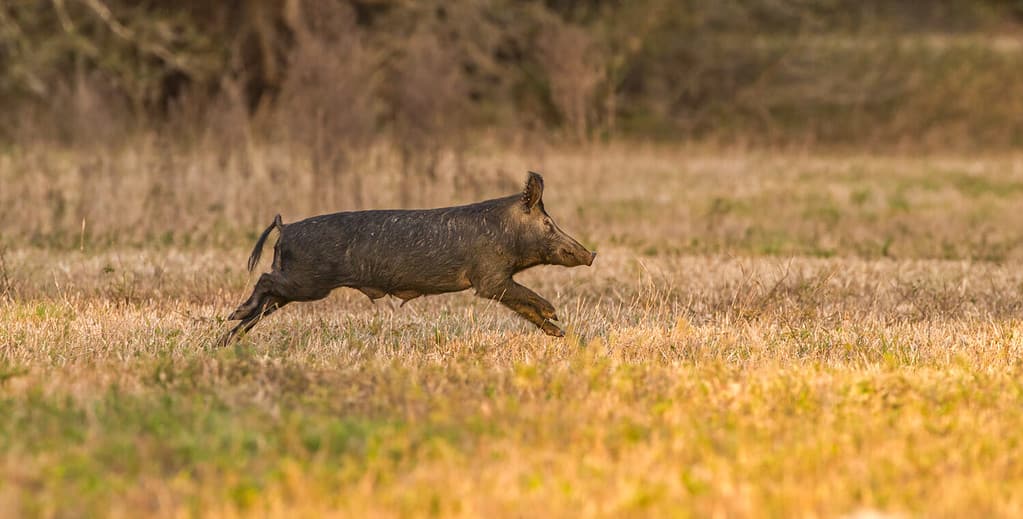Did you know that all wild boars are pigs, but not all pigs are wild boars? Yes, that has a little confusing ring, but it only means that the wild boar is a species of pig. The two are not the same animals. Some people would assume that wild boars are just pigs that have evolved in the wild, while pigs are domesticated animals cultivated for livestock. However, pigs and wild boars are two different animals with their own set of unique characteristics. So, what are the differences between these two mammals? This article will explore the wild boar characteristics vs. pig from their size down to their habitat and diet.
Comparing a Wild Boar and a Pig

What’s the difference between a wild bore and a pig?
Wild refers to non-domestic pigs and pigs refer to domestic pigs. A boar is a non-castrated male, and a hog is either male or female. While these two animals are considered the same species, there are some key differences that are listed below:
| Wild Boar | Pig | |
| Size | 2 to 4 ft (0.63 to 1.2 m) | 3 to 6 ft (0.9 to 1.8 m) |
| Weight | 75 to 100 kg (165 to 220 lb) | 50 to 350 kg (110 to 770 lb) |
| Color | Variety of black, brown, red, and dark gray, sometimes depending on location | Pink (with white hair), black, or reddish brown |
| Habitat | Grasslands, broad-leaved forests, and tropical jungles | Pig barns and outdoor yards |
| Diet | Plants, roots, nuts, acorn, fruits, and tubers | Feeds made of corn, soy, barley, and wheat. Sometimes, they are also fed with “slops”, which are made of vegetable peels, rinds, and leftover food from households. |
| Teeth | With long lower canine teeth that appear as tusks, protruding from the lower mandible. Tusks grow throughout a wild boar’s lifetime. | Smaller canine teeth |
The 5 Key Differences Between a Wild Boar vs Pig
When talking about pigs, most people only think of one thing – the livestock from which pork comes. It may surprise people, but the term “pig” actually encompasses many other species that sport different characteristics. However, the term typically and generally refers to domesticated animals used for livestock. Their wild counterparts, on the other hand, are called wild boars.
Generally, pigs refer to all species found across Europe, Asia, and Northern Africa. Wild boars, warty pigs, and warthogs belong to the pig family. Domesticated pigs have been the common species called pigs, but these domestic pigs came from wild boars, thus their similarities.
Wild Boar vs Pig: Size and Weight
Size and weight are the most apparent differences between a pig and a wild boar. Domesticated pigs are significantly larger and heavier than wild boars, but there is an explanation for that. Since domestic pigs are cultivated as livestock, they are well-fed and thoroughly cared for. Pigs have a wide range of size dimensions depending on their use. Some can be tiny pigs, while some are huge, like the Yorkshire pig. Growing 2 to 4 ft, wild boars can sometimes weigh as much as 250 lbs. However, since they forage and seek their food in the wild, they often do not grow as big as domesticated pigs. Yet, the largest wild boar species, the giant forest hog, can grow up to 6.6 ft, while the heaviest wild boar is a Eurasian wild pig which can weigh up to 710 lbs.
On the other hand, pigs usually grow between 3 and 6 ft, weighing 110 to 770 lbs. Since domestic pigs are bred to be heavier, some species can grow even larger. The biggest domestic pig in history was 5 feet tall but weighed a massive 2,552 lbs, making it to the Guinness World Records.
Wild Boar vs Pig: Color

Compared to pigs, wild boars have darker skin.
One of the most significant and noticeable differences between a wild boar and a pig is their color. Apart from the fact that they live in the wild, wild boars can easily be distinguished from a pig because they typically have darker skin. They commonly sport black, brown, dark gray, or reddish colors based on their region. For instance, wild boars hailing from Western Europe usually have a brown hue, while wild boars hailing from the eastern areas of the continent are typically black.
Pigs also vary in color depending on the species. Some sport yellowish or reddish-brown hues. Most pigs that we know are pinkish, and that is how we easily differentiate a wild boar from a pig. Pink pigs usually have several white hairs, exposing the pinkish hue of their skins.
Wild Boar vs Pig: Habitat
Wild boars, as their name suggests, are typically found in the wild –forests, grasslands, and tropical jungles. Because wild boars search for their plant-based food, they often inhabit areas with healthy vegetation. On the other hand, pigs are cultivated within pig barns and outdoor yards. While they have easier access to healthy food suitable for their bodies and health, they have limited areas to roam compared to wild boars.
Wild Boar vs. Pig: Diet

Wild boars eat plant material like nuts and fruits, while pigs eat wheat and other vegetable-based food.
©Mike Russell/Shutterstock.com
Wild boars are omnivores, mostly eating plant materials like nuts, fruits, and tubers. However, their domesticated counterparts feed on well-mixed nutrients that may contain corn, wheat, and other vegetable-based food and supplements to help them grow bigger and heavier.
Domesticated pigs have become good sources of meat worldwide, used in a variety of ways like hams, bacon, and all sorts of pork. Wild boars are edible, but most people note the remarkable differences, including the presence of nutty and sweet flavor in a wild boar’s meat due to their special diet.
Wild Boar vs Pig: Teeth
One thing that is very noticeable between pigs and wild boars is their set of teeth. Although they share identical dentition or dental structures, the wild boar’s teeth are significantly larger than domesticated pigs. One indication that you are facing a wild boar rather than an ordinary pig is their lower canines protruding too long from their bottom jaws. Some species of wild boars, like the giant forest hog, have lower canines that are highly visible from their mouth. These canines are similar to tusks. Pigs usually do not have canines this long, and as domesticated animals, theirs are usually trimmed.
What U.S. States Allow Wild Boar Hunting?

A total of 28 U.S. states allow wild boar hunting to keep populations in check.
©Chase D’animulls/Shutterstock.com
There are a number of states that allow hunters to target wild boar (feral hogs)–a total of 28 in all. Of those, certain ones allow year-round hunting of them. The other states have either outlawed hunting of these beasts, or they don’t have a significant population. The states that allow feral hogs to be hunted, along with the estimated population of hogs per state, are as follows:
- Alabama (250,000)
- Arkansas (200,000)
- California (400,000)
- Florida (500,000)
- Georgia (600,000)
- Hawaii (600,000)
- Idaho (<100)
- Illinois (unknown)
- Indiana (<1,000)
- Iowa (<1,000)
- Kentucky (2,000)
- Louisiana (750,000)
- Michigan (5,000)
- Mississippi (200,000)
- New Hampshire (unknown)
- New Jersey (<1,000)
- New Mexico (500,000)
- North Carolina (100,000)
- Ohio (2,000)
- Oklahoma (1.5 million)
- Oregon (5,000)
- Pennsylvania (3,000)
- South Carolina (450,000)
- Tennessee (unknown)
- Texas (3.0 million)
- Virginia (3,000)
- West Virginia (<1,000)
- Wisconsin (<1,000)
The top 5 states considered the best for feral hog hunting due to their extreme populations are Texas, Oklahoma, Louisiana, Georgia, and Florida.
The photo featured at the top of this post is © iStock.com/chingkai huang
Thank you for reading! Have some feedback for us? Contact the AZ Animals editorial team.






